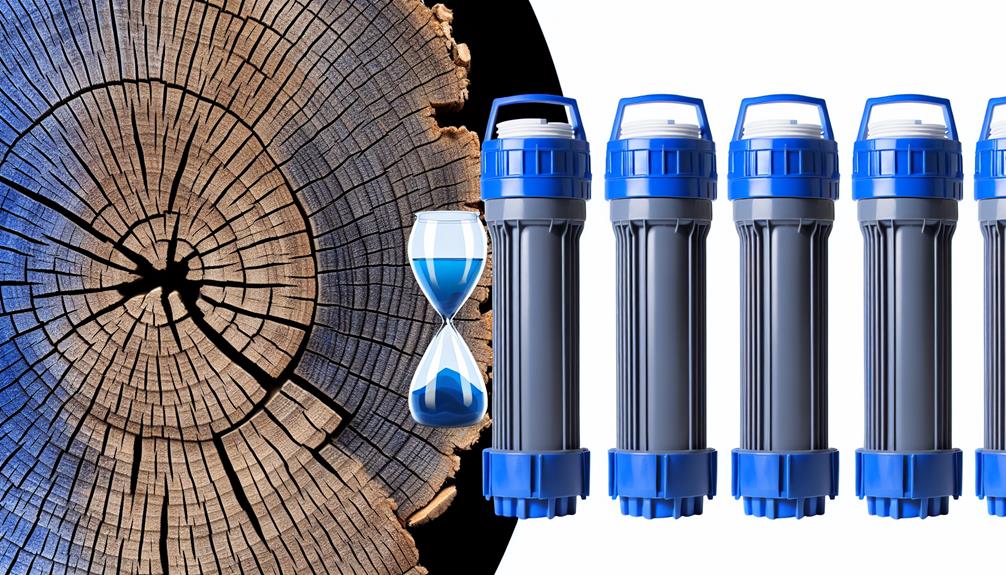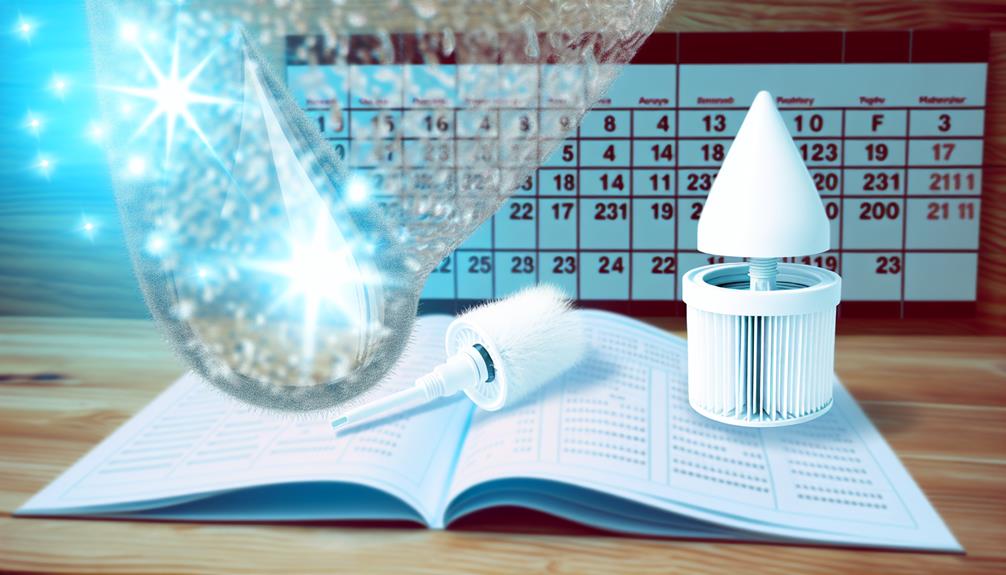You've probably heard the theory that all water filters are created equal, but is there any truth to it when it comes to their lifespan? As you compare top brands, you'll find that each claims to offer the best balance between filtration quality and longevity.
You're aware that variables like water quality and consumption rates can dramatically affect a filter's lifespan, but what about the brand's own technology and materials?
It's time to scrutinize the data behind Brita, PUR, ZeroWater, Culligan, and Aquasana to uncover which one truly stands the test of time. What you discover might not only influence your next purchase but could also redefine how you view the maintenance of your home's water purity.
Brita Filter Lifespan Analysis
How long can you expect your Brita water filter to last before it needs replacing? The lifespan of a Brita water filter, specifically the activated carbon filters commonly used in Brita pitchers, typically hinges on usage and the quality of tap water. However, a general rule is that filters last around two months or filter approximately 40 gallons of water before showing signs that it's time to change.
When conducting a Brita filter lifespan analysis, consider the cost of both the pitcher and the replacement filters. Brita pitchers are available in various sizes and styles, each compatible with Brita's replacement filters. Despite the initial investment in a Brita pitcher, the replacement filters are where the ongoing cost lies. These filters need to be replaced regularly—usually every six months for the average household—to maintain optimal performance.
Analyzing the data, the recurring expense for filter replacements is a critical factor in evaluating the overall value. Brita's commitment to improving tap water taste at an affordable price is balanced against the need for frequent filter life assessments and replacements. Thus, while Brita pitchers are a cost-effective solution upfront, the long-term value hinges on the consistent expense of replacement filters.
PUR Filter Longevity Review
While Brita filters offer a balance between cost and taste improvement, let's examine the lifespan and cost-effectiveness of PUR water filters to see how they stack up in comparison.
The PUR filter longevity review indicates that PUR's water filter pitchers, specifically the Pur Plus models, use carbon block filters designed to last longer due to their denser composition. As a result, you may find that you need to replace the filter less often than with some competing brands.
To hook you into the details:
- PUR filters are engineered to last up to three times as long as some competitors, potentially reaching up to six months instead of the more common two.
- Each replacement is based on usage, typically recommended after every 100 gallons or about every three months for average household use.
- The filtration process is exhaustive, dealing with everything from heavy metals to certain organic compounds, ensuring every gallon filtered meets high purity standards.
- Cost-effectiveness increases with filter longevity, but upfront costs may be higher.
When considering a PUR filter, remember that while the initial investment might be more substantial, the longer intervals between replacements could offer better long-term value. Analyze the data on your usage and compare it with PUR's offerings to make an informed decision.
ZeroWater Replacement Frequency
ZeroWater filters, designed for a 3-5 week lifespan, hinge on both the volume of water used and the initial quality of the tap water. Your water filter system's longevity is critical.
With a 12-cup capacity, the ZeroWater water filter pitcher removes contaminants using a five-stage filter which may last longer than other brands, reducing the need for replacing filters as often. However, if your tap water has a high TDS level, you'll notice the water filtration system's replacement frequency might increase.
Using the included TDS meter is essential for an analytical approach—it guides you on when filters must be replaced, ensuring the water filter pitcher maintains its effectiveness.
Although a ZeroWater filter for sediment and other impurities may cost more upfront, its capacity to filter 40 gallons can provide value over time compared to a standard pitcher filters and even some reverse osmosis systems, which require frequent upkeep.
Culligan Filtration Duration Insights
Turning to Culligan water filters, it's essential to evaluate their filtration duration to understand the maintenance and cost implications for users. Culligan, a brand known for its range of water treatment products, offers various filtration systems each with specific filter lifespans. These lifespans are influenced by factors such as water usage, the concentration of contaminants, and the specific filter model in use.
To give you a clearer picture, here are some key Culligan filtration duration insights:
- Filter Longevity: Culligan water filters have varied lifespans, with some models requiring replacement more frequently than others, depending on the volume of water filtered and the types of contaminants present.
- Performance Comparison: When compared with other top brands, Culligan filters offer competitive filter lifespans, ensuring long periods of filtered water before a replacement is necessary.
- Maintenance Considerations: Regularly checking your water quality report can help anticipate when to replace your Culligan filter, ensuring consistent performance.
- Cost Analysis: The cost-effectiveness of a Culligan system is partly determined by the certified filter lifespan, which can offset initial expenses with longer intervals between changes.
Aquasana Lifespan Comparison
When comparing the lifespan of Aquasana water filters to other leading brands, it's clear that Aquasana's offerings often exceed industry standards for durability and filter longevity. Their under-sink water filters, for instance, utilize solid block carbon, which is renowned for its ability to effectively remove contaminants like heavy metals from water. This solid block carbon technology contributes to a longer filter lifespan compared to typical activated charcoal filters.
In a data-driven analysis, you'll find that Aquasana filters maintain optimal water treatment performance for longer periods. This is partially due to the fact that the flow rate slows down at a lesser pace, indicating a slower accumulation of sediments and contaminants. When the flow rate does eventually decrease, it serves as a natural filter change indicator, prompting you for a carbon filter replacement.
Moreover, water pressure plays a crucial role in assessing the longevity of a filter. Aquasana's design ensures that even as the filter captures more particles over time, the water pressure remains relatively steady. This balance minimizes stress on the filter and extends its life.

